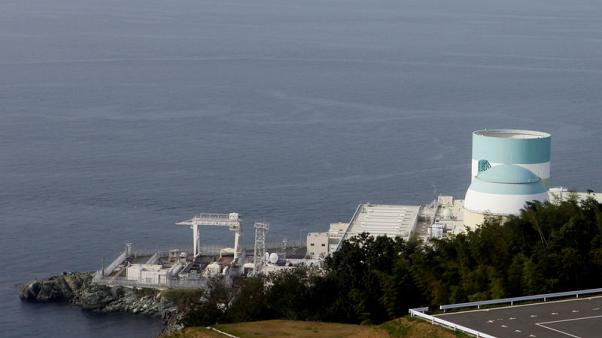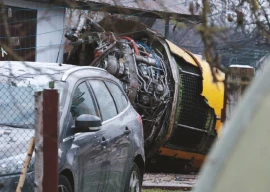
Balancing a tray full of drinks, Sachiyo Ozaki said most of her restaurant’s customers were there because of an industry shunned elsewhere: nuclear power.
“He drives a minivan to take workers to the plant,” she said, gesturing toward a man sitting at the counter. Pointing to another man sipping a beer, she added, “And he works in construction, so they’ve been busy too.”
“We’re all for nuclear power, and you can print that,” Ozaki said.
In the mostly residential neighbourhood around her restaurant, hotel rooms and local inns were also packed with workers preparing to reopen Shikoku Electric Power’s Ikata nuclear plant, nestled next to Japan’s inland sea at the base of the verdant Sadamisaki peninsula. Nearly eight years after an earthquake and tsunami triggered nuclear meltdowns at Tokyo Electric Power’s Fukushima Daiichi plant, the battered industry is making a quiet and somewhat unexpected return in Japan.
How World War I shaped the 20th century and beyond
Ikata is a poster child for that recovery. In September, a court reversed a decision that had idled Shikoku Electric’s sole nuclear reactor for about a year, paving the way for the operator to re-open the facility last week.
Regional utilities like Shikoku Electric have aggressively fought a string of lawsuits since 2011, hiring veteran lawyers to beef up their legal teams. At the same time, they wooed towns where nuclear plants are based, visiting with residents door to door while the government kept up a stream of generous subsidies for local projects.
Thanks in large part to this strategy, Japan is on track to have nine reactors running in the near future.
That is a far cry from the 54 running before 2011 - all of which were idled after the Fukushima disaster - but more than analysts and experts expected, considering it seemed at the time like the end of the road for the country’s nuclear industry.
A Reuters analysis calculates that as few as six more reactors are likely to restart within the next five years, eight will mostly likely be mothballed and that the prospects for two dozen others is uncertain.
Despite that cloudy outlook, nuclear power recently overtook renewables like wind and solar in Japan’s energy mix for the first time since Fukushima.
Court battles
Japan embraced nuclear power after World War II, spurred by the promise of clean energy and independence from foreign suppliers. But the botched Fukushima disaster response sowed public distrust in the industry and the government.
Given that scepticism, some see a recent run of court victories by utilities as the resurgence of an alliance of industry, government and host communities that for decades promoted the construction of nuclear facilities.
“If our losing streak continues, we could see 20 to 25 reactors come back online,” says Hiroyuki Kawai, a prominent anti-nuclear lawyer who represented citizens in a suit against Shikoku Electric.
Since 2011, hundreds of citizens represented by volunteer lawyers like Kawai have filed nearly 50 lawsuits against the Japanese government and utilities in 25 district and appellate courts.
In Ikata, Shikoku Electric spent months gaining approval for a restart from the tougher post-Fukushima regulator, rebooting one of its plant’s three reactors in 2016. But in December 2017, an appellate court issued a temporary injunction keeping the reactor, already idled for routine maintenance, shut down for nine more months.
In response, the company pulled more staff into its legal department and drafted its head of nuclear power to supervise the team. The utility also recruited outside lawyers who had handled cases for other operators.
“There are only a handful of lawyers knowledgeable about nuclear litigation, so they’re popular and sought after,” said Kenji Sagawa, the deputy general manager of the company’s Tokyo office.
Yoshiaki Yamanouchi, 76, began his career in nuclear litigation in 1973 when he represented Shikoku Electric in a landmark suit brought by Ikata residents seeking to stop the plant from opening.
He still represents the utility and works with other companies, advising younger lawyers fighting similar cases, which he calls “superficial,” in far-flung district courts.
“Utilities, in particular Shikoku, have gotten much smarter about fighting for the plants they know they can reopen and mothballing others that would cost too much time and money,” Yamanouchi said. The utility is decommissioning two of the three reactors at Ikata. Shikoku Electric would not disclose how much it has spent fighting legal challenges, but said it was a fraction of the cost of idling a plant.
Every month a nuclear reactor sits inoperative, the utility spends $31 million for additional fuel at its conventional power plants. Shikoku has also spent 190 billion yen on safety upgrades to meet stricter rules set by the Nuclear Regulation Authority.
Activists have seen some victories. Western Japan’s Kansai Electric Power Co Inc has had its reactors slapped with temporary injunction orders multiple times over the years. All of these decisions were later overturned by higher courts. “Before Fukushima, these utilities won by default - now, they have to work harder,” said Yuichi Kaido, a lawyer who has spent three decades dueling Yamanouchi in court.
Shikoku Electric still faces several lawsuits and injunction requests. A Hiroshima court rejected a request from residents to extend the suspension of the Ikata reactor on Oct. 26, a day before the operator restarted it.
A company town
The quiet revival of Japan’s nuclear industry is most tangible in rural areas like Ikata, which are home to the bulk of the country’s nuclear plants.
Japan marks 73rd anniversary of atomic attack on Hiroshima
Ikata is best known for its 'mikan' mandarin oranges harvested on terrace farms on the sides of steep hills overlooking the Seto Inland Sea and Uwa Sea.
The town, with 9,500 residents, relies on nuclear power for a third of its annual revenue. Since 1974, Ikata has received more than $908.4 million in such payments.
These funds literally built the town; Ikata’s roads, schools, hospitals, fire stations and even five traditional 'taiko' drums for festivals were all paid for with subsidies.
“My biggest struggle now is finding one or two more pillars for this town other than nuclear power,” said Ikata Mayor Kiyohiko Takakado.
The town and utility’s mutual dependence stretch back decades.
Kiyokichi Nakamoto was a city councilman in Ikata when he successfully wooed the utility to his hometown. On the walls of the dim parlor of his home are framed commendations from two prime ministers, thanking him for his contributions to Japan’s energy policy.
“We were a poor village with only farming and fishing,” the 90-year old said. Had the town failed to attract the plant, Ikata would have gone broke, Nakamoto said.
In the wake of the Fukushima disaster, Shikoku Electric campaigned to reassure residents of their plant’s safety. Employees wearing the company’s blue uniforms went from house to house to explain how their plant was different from Fukushima Daiichi - and therefore safe.
“If something like Fukushima happened here, our reputation would be destroyed in an instant,” said orange farmer Shigeto Suka, 54, as he checked the still-green mikan on branches.
Japan volcano erupts for first time in 250 years
He and other farmers in Yawatahama, a neighboring town 15 kilometers from the plant, worry that even a hint of contamination would devastate their brand.
After the 2011 nuclear disaster, Fukushima’s farmers and fishermen were unable to sell their produce because of fears over contaminated food. Dozens of countries still have restrictions on Fukushima produce.
For others in the area, the Ikata plant feels like an inextricable part of life.
Hiroshi Omori, 43, spent most days over the summer at Shikoku Electric’s visitors’ house overlooking the Ikata plant. His three young children take free art classes there while Omori and other parents wait in air-conditioned rooms sipping water and tea.
But Ikata is projected to shrink to 5,000 residents over the next 20 years, and Takakado recently said he found it hard to imagine an industry that could replace nuclear power.
This year he joined dozens of other mayors across Japan to voice their support for the industry and ask the government to clarify its position on building new plants or replacing old ones.
“I’m just trying to prevent the town from losing even more people,” he said.





1732618327-2/Untitled-design-(7)1732618327-2-270x192.webp)











COMMENTS
Comments are moderated and generally will be posted if they are on-topic and not abusive.
For more information, please see our Comments FAQ